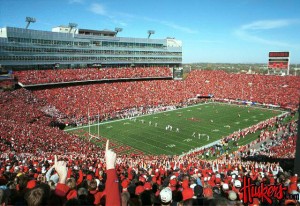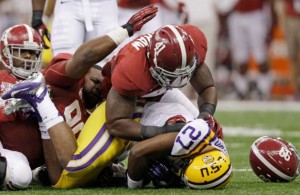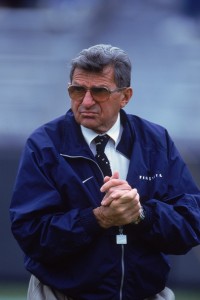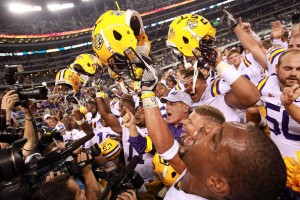Posted on
October 31, 2012 by
JA Allen
 It was a horrible day for a daring football prognosticator who swore Notre Dame was over-rated, who was sure the Gators were worthy of being ranked No. 2 and who predicted the Lions could best the Buckeyes at home in Happy Valley.
It was a horrible day for a daring football prognosticator who swore Notre Dame was over-rated, who was sure the Gators were worthy of being ranked No. 2 and who predicted the Lions could best the Buckeyes at home in Happy Valley.
Like Icarus who flew too close to the sun—Mighty Zultan came too close to perfection. The Football Gods torched his flammable cloak, sending the All-Seeing One headlong into the sink hole of also-rans—where the rest of you dwell.
Except, of course the dozen or so of you who out-guessed Zultan last Saturday.
These distinguished prognosticators will be listed at the end of this article with appropriate kudos for rising above Zultan in Week 9.
Week 10 promises even more untold surprises.
What unlucky unbeaten will fall? Will Nebraska manage to sustain their slight lead and win on the road? Can LSU change the course of football history in 2012? Who knows??
Zultan was mortally wounded in Week 9—managing to hang on at 5-5. He staggered under the weight of expectation. Can he exceed that mark? Make your own picks in Week 10—and go head-to-head with Zultan to defend your choices.
Read the rest of this entry →
Tags: 2012 Big Ten Football2012 College Football Predictions2012 Illinois Football2012 Indiana Hoosiers Football2012 Iowa Hawkeyes Football2012 Michigan State Football2012 Michigan Wolverines Football2012 Minnesota Gophers Football2012 Nebraska Cornhuskers Football2012 Ohio State Football2012 Penn State Football2012 Purdue Boilermakers Footballbeat the zultanCollege FootballCollege Football Predictionsja allenNCAA FootballSports Then and Nowst&nZultan
Category
College Football, Football, JA Allen
Posted on
May 18, 2012 by
JA Allen
 Most of us relish the spectacle of college football on crisp Saturday afternoons, sitting in the stands at a mammoth football stadium in the heart of the Big Ten or the SEC.
Most of us relish the spectacle of college football on crisp Saturday afternoons, sitting in the stands at a mammoth football stadium in the heart of the Big Ten or the SEC.
We love the marching bands, the half-time entertainment and the spontaneous camaraderie in the stands. On game day, whether Division I or II, or III, college football remains as much a part of post-secondary academia as libraries, classrooms and puny-sized dorm rooms.
It comes from our rich heritage—the love we have for our respective alma mater. All this enhanced by football hoopla, beer foam, and online bets with bookies. These incentives—along with the added bounty of bone crushing hits—make us all look forward to the gridiron experience each and every Saturday after Labor Day.
College football IS America in 2012. It is what we have evolved to since the 1950s. Athletes have become bigger, stronger, and faster. Effective training has shaved seconds off scoring dashes down field while increased duration and strength training make the player from 60 years ago to seem almost comical by comparison.
We are assured by experts that modern equipment plus critical changes in football rules provide the modern player with adequate protection on the playing field. Yet, because of the current size and speed of college athletes, the brute force inherent in being tackled or tackling remain exponentially greater than they were even 20 years ago.
 Still the thought of banning college football seems—well—it seems preposterous. It would be like banning Little League or the Pinewood Derby. Life just would not be the same. How could it be?
Still the thought of banning college football seems—well—it seems preposterous. It would be like banning Little League or the Pinewood Derby. Life just would not be the same. How could it be?
But consider this. According to Malcolm Gladwell, well-known author and columnist for the New Yorker magazine, the most compelling reason for banning college football is the number of head injuries college football players sustain in the course of a game, compounded over a season—additionally many seasons.
Read the rest of this entry →
Tags: Buzz BissingerCollege FootballCTEIntelligence Squared U.S.Jason WhitlockMalcolm GladwellTim Green
Category
College Football, Football
Posted on
January 13, 2012 by
Dean Hybl
Much like the BCS Championship Game, the competition to defeat the College Football Zultan during the Sports Then and Now Bowl Challenge proved to be a relative mismatch. Of the many who tried to top the Zultan, only nine individuals were able to exceed his 9-5 record in the major bowl games.
As has been the case for much of the season, the Achilles Heel for the Zultan, as well as many of his challengers, was the Big Ten. The Zultan was burned by Ohio State, Northwestern and Nebraska as all three lost to SEC (or in the case of Northwestern against Texas A&M soon to be SEC) schools. The losses further reminded Big Ten fans that they still have a ways to go to reach par with the top conference in college football.
The Zultan (along with 82% of those who took the bowl challenge) were burned by the Clemson Tigers as West Virginia made a huge statement with their 70 point performance.
Though it doesn’t necessarily take a crystal ball to predict that Nick Saban would out-coach Les Miles in the BCS title game, the Zultan still believed that LSU had a stronger squad than the Crimson Tide and would ultimately pull out the victory. Read the rest of this entry →
Tags: College FootballZultan
Category
College Football, Football
Posted on
November 10, 2011 by
Dean Hybl

Joe Paterno's tenure as head football coach at Penn State is over after 46 years.
The firing of Joe Paterno as head football coach at Penn State is a sad and in some ways shocking twist to a story that has rocked the college football world over the last week and that will perhaps serve as the tipping point for regaining perspective on where college athletics fit within the overall landscape.
Ironically, Paterno is the one coach that many thought already understood the role of college athletics.
Paterno became a legendary figure at Penn State and across college football not just because he was a successful coach on the field, but because it was generally perceived that he and his program “did things the right way.”
From the beginning of his tenure in 1966, Paterno emphasized having his players integrated as part of the educational institution. His players had to not only perform on the field, but also in the classroom. The result is a graduation rate of 78% of football players that ranks well above the national average.
For much of his tenure, it was generally felt that Paterno wasn’t coaching to create a legacy, but instead to provide young men with the tools to be successful well after their football careers were over.
He clearly recognized that a successful college had much more than just a good football team. Paterno and his wife donated millions of dollars to programs around the campus and were instrumental in raising the money for a library extension, which was named in their honor.
However, at some point things started to turn. Maybe it was around the time when Paterno and then-Florida State coach Bobby Bowden started to compete for the honor of having the most wins in Division I-A college football. Maybe it was when Penn State suffered back-to-back losing seasons for the first time ever during his tenure during the 2000 and 2001 campaigns and whispers started as to whether the game had passed him by.
Though the graduation rate of the players never wavered, suddenly Penn State players started piling up as many off the field incidents as they were scoring points on the field. A 2008 investigation revealed 46 Penn State players faced a total of 163 criminal charges. Read the rest of this entry →
Tags: College FootballJoe PaternoPenn State Nittany Lions
Category
College Football, Football
Posted on
October 22, 2011 by
Jena Ellis

The Princeton football program was once more dominant than USC, Alabama or Florida have been in recent generations..
College sports fans often complain about the disparity between the “haves” and “have nots.” In college football, Alabama, Notre Dame, USC and Oklahoma own a bulk of the national titles from the last 90 years. In college basketball, UCLA, Kentucky, Duke, North Carolina, Indiana and Kansas are the dominant six that have presided over the sport over last several decades. While parity may never truly take hold, the powerhouses will likely change over time, as evidenced by the examples of former powerhouses provided below. These programs aren’t nearly as dominant — or nearly as relevant — as they were years ago, but they’ll always have those glory years in which they immeasurably contributed to the evolution of major college athletics.
Princeton Tigers football
With 28 claimed national titles, even Alabama fans are taken aback by Princeton’s early dominance. The Tigers were early adopters of the sport, a variant of rugby, participating in the first-ever football game against Rutgers on November 6, 1869. They lost 6-4, but won the rematch a week later, leading to a split of the first national title. During the first 40 years of college football, the Tigers won 22 national titles, an era of success unparalleled by any other college athletic team — save for their rivals at Yale. Their last national title came in 1950, which was followed by Dick Kazmaier’s Heisman Trophy-winning season in 1951, the only time a Tiger has won the award.
Yale Bulldogs football
During the late 19th century, college football became more structured, closer resembling the sport we know today. Head coaches were being hired for the first time, perhaps the most notable of which was Walter Camp, the “Father of Football,” who finished his playing career at Yale six years before he was hired. He tallied a 67-2 record at the helm, capturing three national titles. None of his successors lost more than two games until 1914, 22 years after he left the program. The foundation he nurtured is the primary reason Yale ranks second all-time in wins behind Michigan, boasts 28 College Football Hall of Fame inductees — such as Amos Alonzo Stagg — and two Heisman winners.
Harvard Crimson football
Yale’s archrival isn’t quite as accomplished, but possesses a rich history of success consisting of 12 national titles and 20 College Football Hall of Fame inductees. Although the Crimson’s last claimed national title came in 1920, a year in which it defeated Oregon in the Rose Bowl, it remains the eighth winningest program in college football history. Their most cherished wins have come in “The Game” — though they trail the series 54-65-8 — which has been played since 1875, making it the second-oldest continuing rivalry in college football. Many of the sport’s rules and traditions were born during the yearly event. Read the rest of this entry →
Tags: Bill RussellChuck BednarikCollege BasketballCollege FootballJay BerwangerPrinceton TigersSan Francisco DonsYale Bulldogs
Category
Basketball, College Basketball, College Football, Football, Great Moments, Sports History
Posted on
September 26, 2011 by
Anderson Melvin

The LSU Tigers have had plenty to shout about during the first month of the 2011 college football season.
Isn’t it hard to believe that something that takes so long to get here, can already be going by this fast? If there’s one thing we’ve learned, it’s that drinking beer and watching football passes the time like no other. The good news is it’s only the first third, and plenty of exciting football remains.
People often say that the polls don’t matter this early. But ascending your way through the rankings and ultimately being crowned #1 is what it’s all about. Seeing as how we are now one-third of the way through the regular season, it seemed like the perfect time to do a special breakdown of what we’ve seen so far from each team. Top 25
1. LSU Tigers (42) (4-0, 1-0 SEC)
So far LSU has been the most impressive team of the season, and are deserving of their new #1 ranking. Three of their four wins have come on the road and have come in dominant fashion. All three against ranked opponents, including last years runner-ups and #3 ranked Oregon. The Tigers may look like the best now, but the daunting SEC West may be too hard to make it out alive. If they keep up their winning ways, they will without a doubt be making a short trip to New Orleans in January.
2. Oklahoma Sooners (12) (3-0, 1-0 Big 12)
The Sooners were jumped by LSU this week despite being alloted top spot to begin the season. With an impressive road victory over the #5 Florida State Seminoles already, the Sooners sit at 3-0 with an easy Ball State opponent coming to Norman. Oklahoma’s next test comes in two weeks when they travel to Austin to face the Longhorns. Read the rest of this entry →
Tags: Alabama Crimson TideCollege FootballLSU TigersOklahoma Sooners
Category
College Football, Football
 It was a horrible day for a daring football prognosticator who swore Notre Dame was over-rated, who was sure the Gators were worthy of being ranked No. 2 and who predicted the Lions could best the Buckeyes at home in Happy Valley.
It was a horrible day for a daring football prognosticator who swore Notre Dame was over-rated, who was sure the Gators were worthy of being ranked No. 2 and who predicted the Lions could best the Buckeyes at home in Happy Valley.




